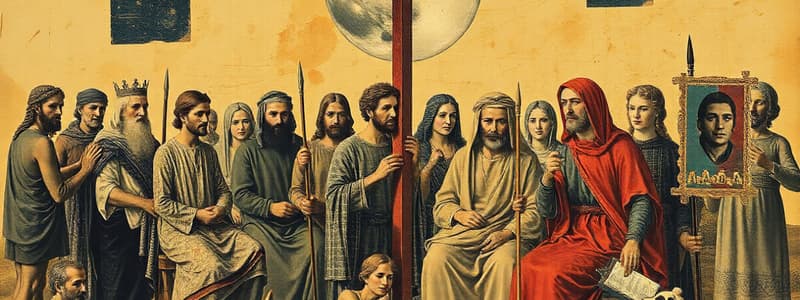Podcast
Questions and Answers
What was the significance of Peter's vision of unclean animals?
What was the significance of Peter's vision of unclean animals?
- It indicated that animal sacrifices were no longer necessary.
- It symbolized the acceptance of Gentiles into the early Church. (correct)
- It highlighted the need for more Jewish followers to be converted.
- It demonstrated that Peter needed to adhere to Jewish dietary laws.
Which statement best captures the response of the Jewish believers after Peter explained his vision?
Which statement best captures the response of the Jewish believers after Peter explained his vision?
- They were indifferent and did not engage in the discussion.
- They demanded strict adherence to Jewish laws for all converts.
- They praised God for the inclusion of Gentiles into the faith. (correct)
- They rejected Peter's reasoning and continued to criticize Gentile inclusion.
At the Jerusalem Council, what was the main issue debated by the apostles and elders?
At the Jerusalem Council, what was the main issue debated by the apostles and elders?
- Whether Gentile converts should learn the Jewish language.
- Whether Paul and Barnabas should continue their missionary journeys.
- Whether Gentiles should be required to follow the Mosaic Law. (correct)
- Whether the Christian faith should remain Jewish only.
Who referred to Scripture to support the inclusion of Gentiles at the Jerusalem Council?
Who referred to Scripture to support the inclusion of Gentiles at the Jerusalem Council?
What was Cornelius's status regarding Jewish law before his encounter with Peter?
What was Cornelius's status regarding Jewish law before his encounter with Peter?
What was the primary outcome of the Jerusalem Council regarding Gentile believers?
What was the primary outcome of the Jerusalem Council regarding Gentile believers?
What was the underlying issue that prompted Paul's confrontation with Peter?
What was the underlying issue that prompted Paul's confrontation with Peter?
What crucial contribution did William Carey make to Indian society during his missionary work?
What crucial contribution did William Carey make to Indian society during his missionary work?
How did Hudson Taylor’s approach to mission work differ from that of many of his contemporaries?
How did Hudson Taylor’s approach to mission work differ from that of many of his contemporaries?
What is a defining characteristic of the African Independent Churches (AICs)?
What is a defining characteristic of the African Independent Churches (AICs)?
What key approach should ministries in rural communities focus on for effective evangelism?
What key approach should ministries in rural communities focus on for effective evangelism?
What is a major challenge faced by ministries in rural areas?
What is a major challenge faced by ministries in rural areas?
Which statement best describes Cross Cultural Missions?
Which statement best describes Cross Cultural Missions?
How are traditional values in rural communities perceived in relation to the Gospel?
How are traditional values in rural communities perceived in relation to the Gospel?
What is essential for effective communication of the Gospel in rural settings?
What is essential for effective communication of the Gospel in rural settings?
What is one of the purposes of Cross Cultural Missions?
What is one of the purposes of Cross Cultural Missions?
What role do churches often play in rural communities?
What role do churches often play in rural communities?
What was a primary reason for the formation of African Independent Churches (AICs)?
What was a primary reason for the formation of African Independent Churches (AICs)?
How do AICs typically integrate elements of worship?
How do AICs typically integrate elements of worship?
What role have AICs played in social and political life?
What role have AICs played in social and political life?
Which characteristic is NOT typically associated with urban contexts?
Which characteristic is NOT typically associated with urban contexts?
What challenge do urban ministries often face?
What challenge do urban ministries often face?
What is a common characteristic of rural contexts?
What is a common characteristic of rural contexts?
How do AICs contribute to the indigenization of Christianity in Africa?
How do AICs contribute to the indigenization of Christianity in Africa?
In urban contexts, what does holistic ministry often involve?
In urban contexts, what does holistic ministry often involve?
Study Notes
Gentile Inclusion in the Early Church
- The early Church was primarily Jewish, with the inclusion of non-Jewish Gentiles causing significant controversy.
- Acts 10-11:
- Cornelius, a Roman Centurion, receives a vision from God instructing him to send for Peter, the apostle.
- Peter receives a similar vision, symbolizing the breaking down of barriers between Jews and Gentiles.
- When Peter preaches the Gospel to Cornelius, the Holy Spirit comes upon both Jews and Gentiles, defying the Jewish tradition of separation.
- Peter's return to Jerusalem sparks criticism for associating with Gentiles.
- He defends his actions by explaining the vision and the Holy Spirit's presence among both groups.
- Acts 15:
- The Jerusalem Council debates the requirement of Jewish Law for Gentile converts, leading to disagreements amongst Jewish Christians.
- The Council decides that salvation comes from faith in Christ, not Jewish law.
- Gentiles should abstain from practices offensive to Jewish Christians, such as eating food sacrificed to idols and sexual immorality.
- This decision paves the way for the expansion of Christianity among Gentiles.
Jewish and Gentile Relations
- Galatians 2:11-14:
- Peter's hypocrisy is highlighted when he initially eats and fellowships with Gentile believers, disregarding Jewish dietary laws.
- He later withdraws due to fear of criticism from Jewish believers, implying Gentile inferiority.
- Paul confronts Peter publicly, emphasizing the truth of the Gospel that both Jews and Gentiles are justified by faith in Christ, not by law.
- This incident highlights the struggle for inclusivity within the early Church and underscores the unity message of the Gospel.
Missionary Movements
- William Carey in India:
- Context: Carey was an English Baptist Missionary who played a pivotal role in spreading the Gospel in India, becoming known as the "father of modern missions."
- Arrival and Early Challenges: Carey arrived in India in 1793, facing opposition from British authorities, language barriers, and cultural differences.
- Significant Contributions: Key contributions included:
- Translating the Bible into several Indian languages.
- Immersing himself in Indian culture and advocating for social reforms, such as the abolition of sati and infanticide.
- Establishment of schools and a printing press, impacting Indian society.
- Hudson Taylor in China:
- Context: Taylor was a British missionary and founder of the China Inland Mission (CIM) with a focus on reaching the inland provinces of China.
- Cultural Adaptation: Taylor adopted Chinese dress and learned the language fluently, establishing a revolutionary approach to mission work.
- Founding the CIM: The CIM was interdenominational with a strong emphasis on faith and reliance on God's provision.
- Challenges: Taylor faced immense hardships, including personal loss and external opposition.
- Legacy: Taylor's mission model influenced numerous other missionary endeavors around the world.
- African Independent Churches (AICs):
- Context: AICs emerged within Christianity in Africa, founded by Africans in response to the limitations of Western mission efforts.
- Formation and Growth:
- They were formed as a reaction to the control of European mission churches and their imposition of Western norms.
- These churches integrate African cultural practices into their worship and emphasize the Holy Spirit, healing, prophecy, and direct encounters with God.
- They have played a significant role in social and political life, particularly during the fight for independence.
- Significance:
- AICs embody the indigenization of Christianity in Africa, integrating the Gospel into local cultural realities.
- They empower and advocate for a sense of ownership over the faith and its expressions.
- AICs represent a diverse and influential segment of African Christianity.
Urban vs. Rural Contexts: Different Approaches and Challenges
- Urban Contexts:
- Characteristics:
- Diversity in ethnicity, culture, religion, and socioeconomic status.
- High population density, leading to both opportunities and challenges.
- Modernization and globalization, potentially creating openness to new ideas but also secularism and materialism.
- Social challenges such as poverty, crime, and substance abuse.
- Approaches:
- Contextualized evangelism:
- Engaging with diverse cultural groups and subcultures, tailoring the message to their specific needs.
- Holistic ministry: Addressing both spiritual and physical needs through programs like job training, addiction recovery, and housing assistance.
- Community building: Fostering a sense of belonging through small groups and social gatherings.
- Use of technology: Utilizing digital platforms to engage a tech-savvy population.
- Contextualized evangelism:
- Challenges:
- Cultural barriers due to urban diversity.
- Busyness and distractions, making it difficult to prioritize spiritual matters.
- Materialism and secularism leading to apathy toward spiritual messages
- Characteristics:
- Rural Contexts:
- Characteristics:
- Homogeneity in culture, ethnicity, and religion.
- Strong, close-knit communities, promoting relational evangelism but requiring trust building for newcomers.
- Traditional values, potentially acting as bridges or barriers depending on the approach.
- Limited resources, including fewer churches, access to technology, and infrastructure.
- Approaches:
- Relational evangelism: Building relationships through long-term engagement and community involvement.
- Community involvement: Hosting events, supporting local traditions, and providing practical help.
- Simple and direct communication: Using clear and practical language applicable to everyday life.
- Sustainable ministry models: Adopting low-cost approaches such as bi-vocational pastors and house churches.
- Challenges:
- Resistance to change, especially if the Gospel message threatens traditional ways of life.
- Isolation, making access to resources and support challenging.
- Limited reach due to a smaller population.
- Characteristics:
Cross Cultural Missions
- Definition:
- It is an apostleship call, involving taking the Gospel across cultural borders, either geographically by travelling to another land or residentially by living among a different tribe.
- It requires a deliberate and conscious effort to break down barriers, requiring sacrifice and humility.
- Purpose:
- To reach and sustain nations far away, utilizing individual strengths and influences.
- To bridge cultural divides and open up hidden nations to discover their worth and resources.
- To connect God's power to other nations through the Gospel.
- Biblical Background:
- God chose the nation of Israel to be priests to other nations (Exodus 19:3-6).
- Jesus gave the Great Commission to go into all the world (Matthew 24:4; 28:19-20).
- The command to reach all nations was emphasized in the early Church (Acts 1:8).
- God manifested His intention to win every tribe, language and culture back to Himself (Acts 2:5-21), fulfilling the prophecy of the end time.
- Paul's Example:
- "To the Jews I became as a Jew, that I might gain the Jews; to them that are under the law, as under the law, that I might gain them that are under the law; to them that are without law, as without law, (being not without law to God, but under the law to Christ,) that I might gain them that are without law. To the weak became I as weak, that I might gain the weak: I am made all things to all men, that I might by all means save some." (1 Corinthians 9:20).
- Challenges:
- Faced with cultural differences, unfriendliness, poverty, and isolation.
- The "scourge of fierce culture" in order to win hearts for Christ.
Types of Missions
- Apostleship: Itinerant missionary with a divine message for a specific group of people in a distinct location and time.
- Full-time missionary: Devotes their life to cross-border mission work, immersing themselves in a community to share the gospel.
- Tentmaker (Bi-vocational missionary): Uses their profession to sustain themselves while evangelizing in a new community.
- Social Ministry missionary: Focuses on alleviating physical needs (medical, educational, or material) in a community, aiming to reach and convert them to Christianity.
- Modern Media Missionary: Utilize modern technology to overcome geographical barriers and spread the gospel through digital platforms and resources.
Cultural Sensitivity and Respect
- Understanding the Culture: Missionaries must immerse themselves in the local culture to understand its values, beliefs, practices, and social norms.
- Building Trust: Respect and honor local customs to cultivate trust and strong relationships within the community.
- Avoiding Cultural Imposition: Focus on finding common ground between the gospel and the local culture, valuing its unique aspects while gently addressing potential conflicts with Christian teachings.
Contextualization of the Gospel
- Adapting Practices: Adapt certain Christian practices to align with local customs. For example, incorporate local music, art, or dance into worship services.
- Biblical Examples: The Apostle Paul adapts his approach depending on his audience, demonstrating the importance of contextualization.
Adapting to Local Languages
- Learning the Language: Critical for effective communication, understanding the needs of the community, and sharing the gospel in a clear and meaningful way.
- Demonstrating Respect: Learning the local language shows respect for the culture and its people, fostering deeper relationships and ministry.
- Overcoming Language Barriers: Overcoming language barriers is essential to effective mission work, even if it is challenging.
Bible Translation and Communication
- Bible Translation: Translating the Bible into the local language enables people to read and understand the gospel in their own context, vital for personal and communal faith development.
- Cultural Nuances in Language: Translating concepts requires understanding cultural nuances, idioms, and expressions to accurately convey the true meaning of the gospel message.
Benefits of Adaptation
- Effective Communication: Adaptation makes the gospel more accessible and relatable, enabling more effective communication.
- Building Relationships: Fosters genuine and trusting relationships, the foundation of successful ministry.
- Cultural Relevance: Improves the acceptance and integration of the gospel within the community, leading to a culturally relevant and sustainable church.
Challenges of Adaptation
- Balancing Adaptation with Faithfulness: Distinguish between culturally appropriate adaptations and compromises to the core message of the gospel.
- Learning Difficulties: Language learning and cultural adaptation can be difficult and time-consuming.
- Navigating Cultural Differences: Some cultural practices may conflict with Christian teachings, presenting ethical challenges.
Challenges Faced by Missionaries in Different Cultural Contexts
- Language Barriers: Difficulty in communication, translation issues, and potential misunderstandings.
- Cultural Misunderstandings: Different worldviews, customs and traditions, and religious practices can lead to misunderstandings and misinterpretations.
- Social and Relational Challenges: Difficulty in building trust, cultural integration, and managing family life in a new cultural setting.
- Ethical and Moral Dilemmas: Navigating cultural practices that conflict with Christian ethics, potential for syncretism.
- Political and Legal Challenges: Restricted religious freedom, political instability, and cultural nationalism.
- Emotional and Psychological Challenges: Culture shock, isolation and loneliness, burnout.
- Resistance and Opposition: Local resistance, opposition from religious authorities.
- Practical and Logistical Challenges: Difficult living conditions, resource limitations, and ensuring sustainability.
Studying That Suits You
Use AI to generate personalized quizzes and flashcards to suit your learning preferences.
Description
Explore the pivotal moments of Gentile inclusion in the early Church as described in Acts 10-15. Discover how visions and the Jerusalem Council shaped the understanding of faith and salvation for both Jews and Gentiles, and the controversies that emerged during this transformative period.




